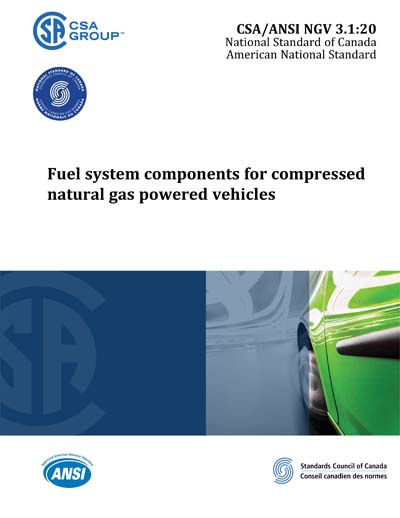Historical
CSA/ANSI NGV 3.1-2020
Fuel system components for compressed natural gas powered vehicles
Preface This is the fourth edition of CSA/ANSI NGV 3.1, Fuel system components for compressed natural gas powered vehicles. It supersedes the previous editions published in 2014, 2012, and 1995 as ANSI NGV 3.1 • CSA 12.3. The major changes to this edition include the following: a) References have been updated. b) Editorial/notation changes have been made to improve readability. c) Notes have been added for guidance. d) Technical changes have been made to the following Clauses: 5.3.3, 5.4, 5.5, 5.7.3.3, 5.11, 7.3, 7.4, 10.4.2, 14.4.4, 14.4.6, and 16.4.4.2. e) The following new Clauses have been added: 5.16, 6.5, 9.4.3.1, 9.4.4, 10.4.4, 11.3, 11.4.4, 11.4.5, 15.4.4.3, 19.4.6, 19.4.8, and 21.4.2. CSA Group acknowledges that the development of this Standard was made possible, in part, by the financial support of Natural Resources Canada. This Standard has been developed in compliance with Standards Council of Canada requirements for National Standards of Canada. It has been published as a National Standard of Canada by CSA Group. This Standard has been approved by the American National Standards Institute (ANSI) as an American National Standard. Scope 1.1 This Standard establishes requirements for newly produced compressed natural gas fuel system components, intended for use on natural gas powered vehicles, as listed in Table 1 below. Table 1 - Fuel system components - (See Clauses 1.1 and 1.5.) Check valves Manual valves Manual container valves - Automatic valves - Gas injectors - Pressure indicators - Pressure regulators - Gas flow adjusters - Gas/air mixers - Pressure relief valves - Pressure relief devices - Excess flow valves - Gas-tight housing and ventilation hoses - Rigid fuel lines - Flexible fuel line, hoses, and assemblies - Filters - Fittings - Discharge line closures 1.2 This Standard applies to devices that have a service pressure (SP) of either 16 500 kPa (2400 psi), 20 700 kPa (3000 psi), or 24 800 kPa (3600 psi), hereinafter referred to in this Standard as the following: a) "P24" – 16 547 kPa (2400 psi); b) "P30" – 20 684 kPa (3000 psi); or c) "P36" – 24 821 kPa (3600 psi). The Standard also applies to components downstream of the first stage of pressure reduction. 1.3 The construction of the noted components, whether specifically covered by the various provisions of this Standard or not, should be in accordance with reasonable concepts of safety, performance, and durability. 1.4 All specifications as to construction set forth herein should be satisfied by the construction actually prescribed or such other construction as will provide at least equivalent performance. 1.5 This Standard emphasizes the pressure containment, performance, and safety characteristics of components listed in Table 1. 1.6 It is recognized that other components not specifically covered herein can be examined to meet the criteria of this Standard and tested according to the appropriate functional needs. 1.7 This Standard does not apply to the following: a) natural gas fuel system components incorporated during the manufacture of motor vehicles originally manufactured in compliance with the Federal Motor Vehicle Safety Standards (FMVSS) for Compressed Natural Gas Fueled Vehicles and the Canadian Motor Vehicle Safety Standard (CMVSS); b) fuel containers; c) stationary gas engines; d) container mounting hardware; e) electronic fuel management; f) fuelling receptacles; or g) three-way valves. 1.8 In the case of conflict between this Standard and federal, provincial, state, or local requirements, the government requirements should take precedence. 1.9 All references to "kPa (psi)" throughout this Standard should be considered gauge pressures, unless otherwise specified. 1.10 This Standard contains SI (metric) units corresponding to the yard/pound quantities, the purpose being to allow the Standard to be used in SI (metric) units. IEEE/ASTM SI 10, American National Standard for Metric Practice, or ISO 80000-1:2009 Quantities and units — Part 1: General, is used as a guide in making metric conversion from yard/pound quantities. If a value for a measurement and a corresponding value in other units are stated, the first stated value should be regarded as the requirement. The given corresponding value may be approximate. If a value for a measurement and a corresponding value in other units, are both specified as a quoted marking requirement, the first stated unit, or both, are to be provided. 1.11 In this Standard, "shall" is used to express a requirement, i.e., a provision that the user is obliged to satisfy in order to comply with the Standard; "should" is used to express a recommendation or that which is advised but not required; and "may" is used to express an option or that which is permissible within the limits of the Standard. Notes accompanying clauses do not include requirements or alternative requirements; the purpose of a note accompanying a clause is to separate from the text explanatory or informative material. Notes to tables and figures are considered part of the table or figure and may be written as requirements. Annexes are designated normative (mandatory) or informative (non-mandatory) to define their application. 1.12 The values given in SI units are the units of record for the purposes of this Standard. The values given in parentheses are for information and comparison only.
Content Provider
CSA America, Inc. [csa]






